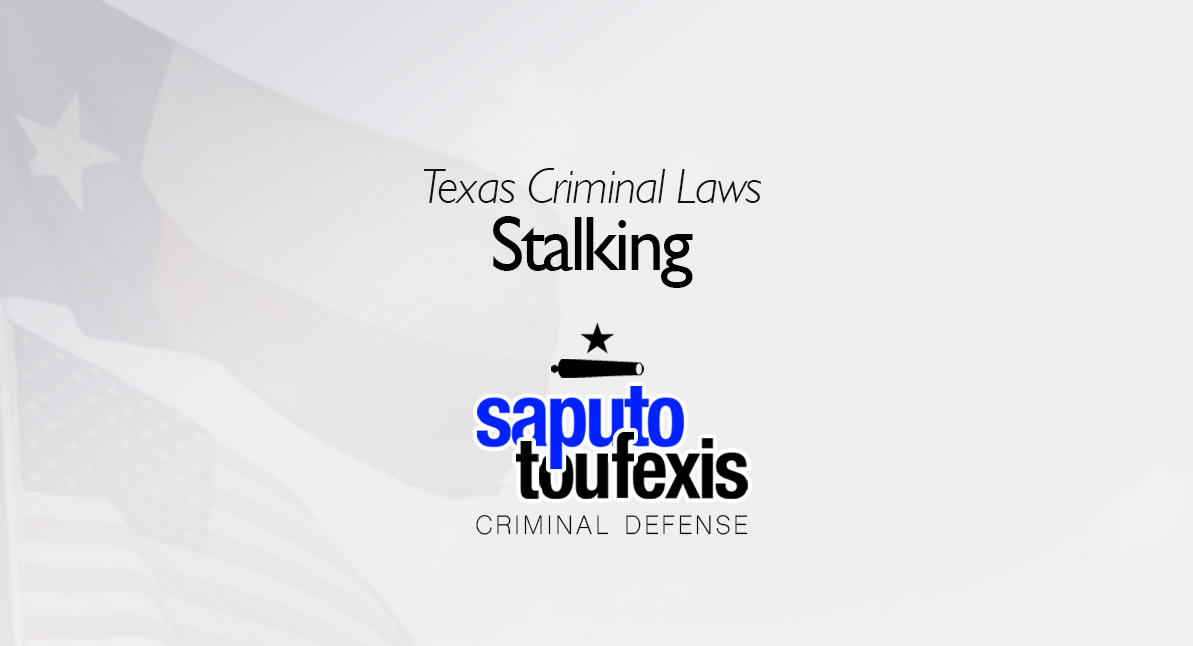The Texas Stalking law is essentially the more serious, felonious version of the Texas offense of Harassment.
FAQs about the
Stalking law in Texas
- What is the current Texas law about Stalking?
- What is the penalty for a Texas Stalking offense?
- What are typical instances of Stalking?
- What type of property does the Stalking law refer to?
- Can you be convicted of Stalking if you don’t harm anyone or anyone’s property?
- What changed in 2023?
- What changed in 2025?
- What is the statute of limitations for Stalking in Texas?
- Can you get probation for Stalking in Texas?
- What level of crime is Stalking in Texas?
- Can a Texas Stalking offense be reduced?
Stalking requires repeated instances of harassing or threatening behavior. There is an objective “reasonable” standard placed on the target, so that if someone claims he or she is being stalked, it does not rise to the level of criminal Stalking if he or she is simply oversensitive.
Have you been charged with Stalking? Contact us today to discuss legal representation.
or Text or Call (888) 239-9305
The Harassment offense becomes the more severe crime of Stalking if Harassment occurs on multiple occasions against the same individual and the accused knowingly engages in the conduct. Even if not defined as Harassment under the Texas Penal Code, behavior threatening bodily harm or an offense against property could be the basis for a Stalking charge under the law.
The Texas legislature codified this criminal offense in Texas Penal Code Section 42.072. The legislature most recently updated this law in 2023 by expanding the description of Stalking beyond the harassment standard to include feeling terrified or intimidated, in addition to making other changes to the language in the statute. And then in 2025, the legislature added Stalking to the list of offenses for which judges are not able to grant probation.
The Penal Code classifies the Texas Stalking law under Title 9 “Offenses Against Public Order and Decency,” Chapter 42 “Disorderly Conduct and Related Offenses.” Learn more about the Texas offense of Stalking below.
What is the current Texas law about Stalking?
Texas law currently defines the offense of Stalking in Penal Code Section §42.072 as follows:[1]
(a) A person commits an offense if the person, on more than one occasion and pursuant to the same scheme or course of conduct that is directed at a specific other person, knowingly engages in conduct that:
(1) constitutes an offense under Section 42.07, or that the actor knows or reasonably should know the other person will regard as threatening:
(A) bodily injury or death for the other person; or
(B) that an offense will be committed against:
(i) a member of the other person’s family or household;
(ii) an individual with whom the other person has a dating relationship; or
(iii) the other person’s property;
(2) causes the other person, a member of the other person’s family or household, or an individual with whom the other person has a dating relationship:
(A) to be placed in fear of bodily injury or death or in fear that an offense will be committed against the other person, a member of the other person’s family or household, or an individual with whom the other person has a dating relationship, or the other person’s property; or
(B) to feel harassed, terrified, intimidated, annoyed, alarmed, abused, tormented, embarrassed, or offended; and
(3) would cause a reasonable person under circumstances similar to the circumstances of the other person to:
(A) fear bodily injury or death for the person;
(B) fear that an offense will be committed against a member of the person’s family or household or an individual with whom the person has a dating relationship;
(C) fear that an offense will be committed against the person’s property; or
(D) feel harassed, terrified, intimidated, annoyed, alarmed, abused, tormented, embarrassed, or offended.
This version of the Stalking offense has been effective since 2023. The legislature amended the statute, effective September 1, 2023, so conduct occurring before that date require application of the old statute.
The Stalking statute covers acts committed toward an alleged victim’s “family” (a defined term[2]) or a member of that individual’s “household” (also a defined term[3]). The Stalking statute also includes acts towards someone who is in a “dating relationship” (another defined term[4]) with the alleged Stalking victim.
What is the penalty for a Texas Stalking offense?
The crime of Stalking under the Texas Penal Code is typically a third-degree felony. However, repeated convictions for Stalking offenses can be enhanced to felonies of the second-degree. This is a more severe punishment than the crime of Harassment, a misdemeanor. To see the punishments for third and second-degree felonies in comparison to misdemeanor punishments, see our Range of Punishments page.
What are typical instances of Stalking?
Some typical examples of Stalking behavior are repeated threatening or harassing phone calls, following someone, showing up to someone’s workplace, or vandalizing someone’s property.
What type of property does the Stalking law refer to?
The type of property referred to by the Stalking statute includes property such as a car or a pet. If someone vandalizes your car repeatedly, or vandalizes your car and then a garage door at your house for example, this behavior could be found to be Stalking because its purpose is to harass or threaten you.
Another common Stalking charge results from an instance where someone’s pet is harmed. This may be considered a behavior that implicitly threatens violence. Because property damage may be alleged to implicitly threaten someone with violence, property damage is included in the Stalking statute.
Can you be convicted of Stalking if you don’t harm anyone or anyone’s property?
You can be charged and convicted of Stalking even if you don’t actually physically harm someone or their property. Stalking means that the behavior causes another to feel threatened or harassed. No actual injury is required. Also, the threats can be explicit, such as a text message or voicemail that says someone is going to hurt another person, or the threats can be implicit. Implicit threats are those such as following someone in an attempt to intimidate them, or indirectly harming their property.
In addition, if you get someone else to make a threat, explicitly or implicitly, then you can still be convicted of Stalking. As a result, you can be convicted of Stalking for the behavior of someone else and without causing any actual injury to that individual or their property.
What changed in 2023?
In 2023, the Legislature amended the Stalking law to change specific wording and broaden its scope.[5] Here’s what changed in the statute:
- The phrase “directed specifically at another person” was simplified to “directed at a specific other person.”
- Where the old law limited threats to bodily injury, death, or property damage, the amendment clarified that threats may also extend to family members, household members, or dating partners of the alleged victim, not just the victim or their property.
- The list of emotional responses was expanded. The old statute required proof that the victim felt “harassed, annoyed, alarmed, abused, tormented, embarrassed, or offended.” The new law added “terrified” and “intimidated” to that list.
- The “reasonable person” test was rephrased. The old law asked whether the conduct would cause a reasonable person to fear harm or feel harassed. The new law requires proof that a reasonable person “under circumstances similar to the circumstances of the other person” would experience those fears or feelings, tying the standard more closely to the victim’s situation.
Overall, these language changes make the statute broader and more flexible, giving prosecutors additional avenues to prove stalking by expanding the categories of protected victims, the range of prohibited conduct, and the scope of the reasonable person standard.
These changes were effective only for conduct occurring on or after September 1, 2023.[6]
What changed in 2025?
In 2025, the Texas Legislature also made Stalking ineligible for judge-ordered community supervision by adding the offense to the list of crimes excluded under Article 42A.054(a) of the Code of Criminal Procedure.[7] This change applies only to convictions for conduct occurring on or after September 1, 2025.[8] Note that the leigslature did not make any changes regarding the ability of juries to reccomend community supervision for Stalking offenses.
What is the statute of limitations for Stalking in Texas?
Stalking offenses have a three-year limitations period.[9]
Can you get probation for Stalking in Texas?
The Texas Code of Criminal Procedure allows juries to recommend probation for Stalking, and judges are also allowed to accept deferred adjudication plea deals.[10]
However, judges may no longer grant community supervision after a conviction for Stalking offenses where the offense conduct happened after September 1, 2025, since the legislature added this offense to the list of crimes excluded from judge-ordered probation under Article 42A.054(a).[11] The legislature did not enact the same limitation for jury-recommended probation, however.
In addition, no matter the offense, neither judges nor juries may recommend community supervision for any suspended sentence of over 10 years.[12] Judges also may not grant community supervision after a conviction if (1) the defendant used or exhibited a deadly weapon during the commission of the felony or immediate flight thereafter and (2) the defendant used or exhibited the deadly weapon himself or was a party to the offense and knew that a deadly weapon would be used or exhibited.[13]
What level of crime is Stalking in Texas?
The Penal Code classifies Stalking as either a second or third degree felony, depending on the circumstances.
Learn more about the penalty range for this offense in the section above.
Can a Texas Stalking offense be reduced?
A Stalking charge can be reduced to a misdemeanor Harassment charge.
Legal References:
^1. Texas Penal Code §42.072. This law is current as of 2025.^2. Family Code Section 71.003 – “Family” includes individuals related by consanguinity or affinity, as determined under Sections 573.022 and 573.024, Government Code, individuals who are former spouses of each other, individuals who are the parents of the same child, without regard to marriage, and a foster child and foster parent, without regard to whether those individuals reside together.^3. Family Code Section 71.005 – “Household” means a unit composed of persons living together in the same dwelling, without regard to whether they are related to each other.^4. Family Code Section 71.0021(b)-(c) – (b) “dating relationship” means a relationship between individuals who have or have had a continuing relationship of a romantic or intimate nature. The existence of such a relationship shall be determined based on consideration of: (1) the length of the relationship; (2) the nature of the relationship; and (3) the frequency and type of interaction between the persons involved in the relationship. But see subsection (c): “A casual acquaintanceship or ordinary fraternization in a business or social context does not constitute a “dating relationship” under Subsection (b)”^5. SB 1717, 88th Legislature (RS), Section 2^6. SB 1717, 88th Legislature (RS), Section 3^7. SB 1021, 89th Legislature (RS), Section 1^8. SB 1021, 89th Legislature (RS), Section 2^9. See Code of Criminal Procedure 12.01(9)^10. See Chapter 42, Texas Code of Criminal Procedure, Art. 42A.054, Art. 42A.056, Art. 42A.102^11. SB 1021, 89th Legislature (RS), Section 1^12. Art. 42A.053(c), Texas Code of Criminal Procedure^13. Art. 42A.054(b), Texas Code of Criminal Procedure










